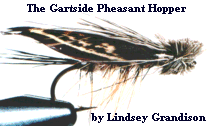The Gartside Pheasant Hopper

Tied by Lindsey Grandison, grandiso@umdnj.edu
This fly is was originated by Jack Gartside and is described in one of books
but I'm not sure which one. References with photographs may be found in "The
Book of Fly Patterns" by Eric Leiser and "Flies for Trout" by Dick Stewart
and Farrow Allen.
PATTERN:
Hook: Dry Fly, 2XL, such as Mustad #94831, #6-#12
Thread: Match of body color, Monocord #3/0
Tail: Dark Moose Body hair fibers, gap width in length past hook bend
Rib: Furnace hackle palmered over body. Barbules cut from top half. Barbules
on bottom half are tapered so that fibers are a half a gap width at hook barb
and a full gap length at eye at end of body
Body: Poly Yarn. Appropriate colors include yellow, tan, gray, or olive
Underwing: A dozen very fine natural brown deer hair fibers to center of tail
Wing: Mottled ringneck pheasant back feather dipped in spar varnish and
dried. Tip V-notched.
Collar: Dozen natural brown deer hair fibers tied along sides of body and
extend half a shank length
Head: Deer hair spun and trimmed square in shape. Colr is natural gray or
dyed tan, olive, or other.
Notes on tying:
The pheasant back feather used in my ties is known as the church window
feather. There are other feathers back there that will also give intriguing
flies. I used Dave’s Flexament (thinned out with thinner) to treat the
feather. Dipped feather into the cement and took off excess with a bodkin.
Then set the feather to dry. Stand the feather upright by placing the stem in
a narrow hole made in a thick styrofoam sheet. This was the most successful
way of drying the treated feather. The cement will attach the feather to any
surface you place it on.
Notes on submitted fly:
Size #8, Mustad #94831 was used. The body was made from tan poly yarn and the
thread used was #6 tan.
BACK TO TFS

